new posts in all blogs
Viewing: Blog Posts Tagged with: reference, Most Recent at Top [Help]
Results 26 - 50 of 333
How to use this Page
You are viewing the most recent posts tagged with the words: reference in the JacketFlap blog reader. What is a tag? Think of a tag as a keyword or category label. Tags can both help you find posts on JacketFlap.com as well as provide an easy way for you to "remember" and classify posts for later recall. Try adding a tag yourself by clicking "Add a tag" below a post's header. Scroll down through the list of Recent Posts in the left column and click on a post title that sounds interesting. You can view all posts from a specific blog by clicking the Blog name in the right column, or you can click a 'More Posts from this Blog' link in any individual post.

By: Kathy Temean,
on 7/29/2014
Blog:
Writing and Illustrating
(
Login to Add to MyJacketFlap)
JacketFlap tags:
list,
Book,
reference,
authors and illustrators,
Publishing Industry,
How to,
need to know,
demystify,
2014 NJSCBWI Conference,
Amazon Ranking vs. Daily Book Sales,
How to Sell More Books,
Add a tag
Thought you might be interested in the information I presented at the “How to Sell More Books” Workshop I gave at the NJSCBWI Conference in June. You might want to use it as a general rule of thumb when checking out your book (on other books) on Amazon.

Talk tomorrow,
Kathy
Filed under:
authors and illustrators,
Book,
demystify,
How to,
list,
need to know,
Publishing Industry,
reference Tagged:
2014 NJSCBWI Conference,
Amazon Ranking vs. Daily Book Sales,
How to Sell More Books 


By: Kathy Temean,
on 7/23/2014
Blog:
Writing and Illustrating
(
Login to Add to MyJacketFlap)
JacketFlap tags:
Agent,
Author,
reference,
Advice,
video,
Process,
revisions,
opportunity,
Martha Alderson,
Plot Whisperer,
Jill Corcoran,
Novel Revsion Video series,
Add a tag
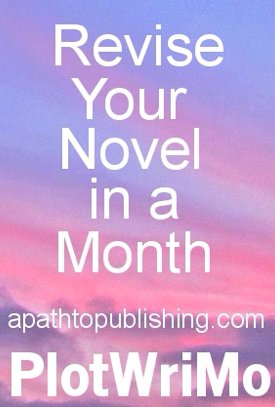 Since, agent Jill Corcoran is such a good marketer, I am sure most of you already know about the video series that author of the PLOT WHISPERER, Martha Alderson and literary agent Jill Corcoran released three months ago.
Since, agent Jill Corcoran is such a good marketer, I am sure most of you already know about the video series that author of the PLOT WHISPERER, Martha Alderson and literary agent Jill Corcoran released three months ago.
You can watch the first video in the series for free, which I did last week. It was very good and since I watched it, I’ve been wondering how I could come up with the money to rent the rest of the series.
Today, Martha and Jill lowered the price to $75.00 to rent the 8 part series for a whole year, so now I can afford to buy the series and learn from what they have put together.
If you are a picture book writer, they even have something for you. You can pre-order: How to Write & Sell A Picture Book- Pre-Order and SAVE $25 https://vimeo.com/ondemand/writesellpicturebook
Here is the information for the Revising Your Novel in a Month: http://vimeo.com/ondemand/reviseyournovelinamonth
In this 8 Video (5.5 hours) Series, Plot Whisperer Martha Alderson and Literary Agent Jill Corcoran provide step-by-step instruction on how to revise your
• Concept
• Structure and design
• Tension and conflict
• Character growth and transformation
• Pacing
• Cause and effect
• Meaning
• Hook
• Polish
• Prose
in preparation for a major rewrite of your novel.
To complete the course in a month, watch two videos a week. Or, work at your own pace and take more or less time on the step-by-step exercises. You decide your revision pace as you explore and complete each video exercise based on your own individual needs in preparation for a major rewrite.
• 8 videos (available for viewing as many times as you would like for 1 year)
• 30 writing exercises- one for each day of the Revise Your Novel Month
apathtopublishing.com/for-those-who-purchased-aptp-videos/
PlotWriMo: REVISE YOUR NOVEL IN A MONTH
I. TRAILER
a. Introduction
II. OVERALL STORY LEVEL
a. Video #1: HOW TO REVISE + CONCEPT & CHARACTERS
• Welcome
• How to Approach Revision
• Organization
• Concept
• Characters
• Story Titles
III. PLOT AND STRUCTURE LEVEL
a. Video #2: TRANSFORMATION + GOALS
• Review
• Layers of Plot
• Transformation / Change
• Goals
b. Video #3: CONCEPT + ENERGETIC MARKERS
• Review
• Concept
• Energetic Markers
• Plot Planner
IV. SCENE LEVEL
a. Video #4: SCENES AND THEMES
• Review
• Scene and Summary
• Themes
• Character Motivation
• Antagonist
b. Video #5: CLIMAX
• Review
• Preparation
• Anticipation
• Event
• Reaction
• 3 Major Plot Lines
• Antagonist Crisis
c. Video #6: BEGINNING & END
• Review
• Beginning
• Traits, Skills, Knowledge, Beliefs
• Cause and Effect
• Antagonists
V. WORD LEVEL
a. Video #7: MANUSCRIPT VOICE + CHARACTER & ACTION
• Voice
• Transformational Journey
• Backstory Wound
• Subplots and Theme
• Crisis
b. Video #8: FIRST PAGES + FINAL TEST
• Every Word Perfect
• Sentence structure
• Dialog
• Prepare for Rewrite
• Rewrite
• Concept
• Structure and design
• Tension and conflict
• Character growth and transformation
• Pacing
• Cause and effect
• Meaning
• Hook
• Polish
• Prose
To complete the course in a month, watch two videos a week. Or, work at your own pace and take more or less time on the step-by-step exercises. You decide your revision pace as you explore and complete each video exercise based on your own individual needs in preparation for a major rewrite.
• 8 Instructional videos (available for viewing as many times as you would like for 1 year)
• 30 writing exercises- one for each day of the Revise Your Novel Month
Who will benefit from PlotWriMo: Revise Your Novel in a Month:
• Writers seeking to write a great novel
• Writers with a draft of a novel and uncertain how to proceed
• Writers with story problems
• Writers who feel blocked
• Writers who wish to move from where they are to where you wish to be
• Writers committed to improving your craft
• Writers interested in digging deeper into your story
• Writers needing help organizing for a major rewrite
Dolly D. Napal watched the series and said, “Don’t let the title fool you. This is not only a revision course. It’s a fully comprehensive writing course for PB, MG, YA, and Adult writers, at any point in their career.”
Talk tomorrow,
Kathy
Filed under:
Advice,
Agent,
Author,
opportunity,
Process,
reference,
revisions,
video Tagged:
Jill Corcoran,
Martha Alderson,
Novel Revsion Video series,
Plot Whisperer 

Here is a list of publishers who look to publish digital books. I thought you might like to keep this list for future reference, a good list to research. Note: The number of deals are only the ones reported to Publishers Marketplace.
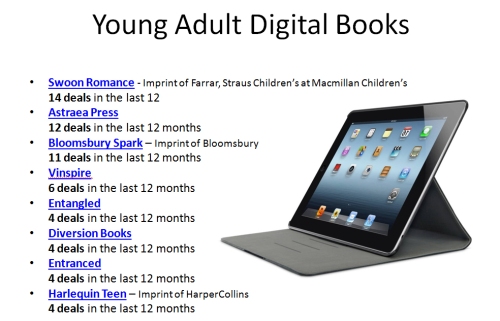
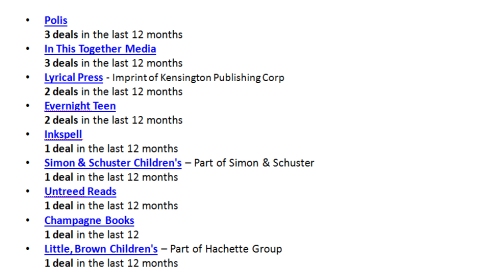
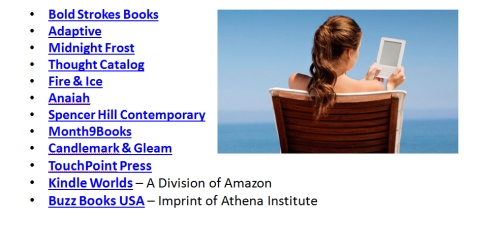
Talk tomorrow,
Kathy
Filed under:
list,
Places to sumit,
publishers,
Publishing Industry,
reference,
Young Adult Novel Tagged:
2014 State of the Market Report,
YA Digital Publishers 


By: Kathy Temean,
on 6/24/2014
Blog:
Writing and Illustrating
(
Login to Add to MyJacketFlap)
JacketFlap tags:
Astraea Press,
Swoon Romance,
Bloomsbury Spark,
2014 Top ebook Publishers,
Young Adult ebook deals,
reference,
Digital Books,
Self-publishing,
publishers,
authors and illustrators,
Places to sumit,
Add a tag
I’m busy working on my presentation for The State of the Market Report that I’m giving at the NJSCBWI conference to kick off Sunday morning. The report is chuck full of statistics, survey answers from editors and agents, and lots of analyst. Since all of my time has been going into that report and not on my blog, I thought I would give you a glimpse.
Young Adult ebooks are doing really well and I know many of you are considering going the digitally root hoping to ride that wave. I was surprised how many digital publishers are out there and since this research taught me things, I thought you might be interested in seeing the list and the number of deals each had during the last year. Please note some publishers were not in business for the full year.
Swoon Romance
14 deals in the last 12
Astraea Press
12 deals in the last 12 months
Bloomsbury Spark
11 deals in the last 12 months
Vinspire
6 deals in the last 12 months
Entangled
4 deals in the last 12 months
Diversion Books
4 deals in the last 12 months
Entranced
4 deals in the last 12 months
Harlequin Teen
4 deals in the last 12 months
Polis
3 deals in the last 12 months
In This Together Media
3 deals in the last 12 months
Lyrical Press
2 deals in the last 12 months
Evernight Teen
2 deals in the last 12 months
Inkspell
1 deal in the last 12 months
Simon & Schuster Children’s
1 deal in the last 12 months
Untreed Reads
1 deal in the last 12 months
Champagne Books
1 deal in the last 12
Little, Brown Children’s
1 deal in the last 12 months
Bold Strokes Books
1 deal in the last 12
Adaptive
1 deal in the last 12 months
Midnight Frost
1 deal in the last 12 months
Thought Catalog
1 deal in the last 12 months
Fire & Ice
1 deal in the last 12 months
Anaiah
1 deal in the last 12 months
Spencer Hill Contemporary
1 deal in the last 12 months
Month9Books
1 deal in the last 12 months
Candlemark & Gleam
1 deal in the last 12 months
TouchPoint Press
1 deal in the last 12 months
Kindle Worlds
1 deal in the last 12 months
Buzz Books USA
1 deal in the last 12 months
Now it is time to do your homework to see if any of them are a good fit for you.
Talk tomorrow,
Kathy
Filed under:
authors and illustrators,
Places to sumit,
publishers,
reference,
Self-publishing Tagged:
2014 Top ebook Publishers,
Astraea Press,
Bloomsbury Spark,
Digital Books,
Swoon Romance,
Young Adult ebook deals 

Author Tara Lazar posted a list of Fun Words on her blog. I have done a number of Word Lists on this blog, so as not to reinvent the wheel, I copied Tara’s list and deleted some words so you would have to visit her site. To the right of the column, I added some of my own fun words. I’m sure you have a bunch of words you could add. If you do, just leave them in the comments.
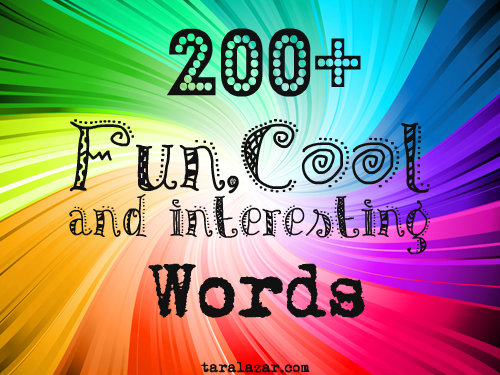
All writers love language. And we especially love fun words, don’t we? Some have funky spellings, tongue-twisting turns, a satisfying “ooh”…and some sound too hilarious to be true! So I’ve put together a list of favorite fun words that I’ll add to periodically. Have fun, lexicon lovers!
- aficionado
- akimbo
- alfresco
- ambrosial
- anemone
- aplomb
- apoplectic
- appaloosa
- Arietta
- avuncular
- balderdash
- bamboozle
- barnstorming
- befuddled
- berserk Bilge
- boffo
- bombastic
- boondoggle
- bozo
- braggadocio Brewski
- brouhaha
- bucolic
- buffoon Buffoonery
- bulbous
- bumbledom
- bungalow
- cacophony Caboodle
- cahoots
- candelabra
- canoodle
- cantankerous
- caterwaul
- catawampus Chameleon
- chichi
- chimichanga
- claptrap Clairvoyant
- clodhopper
- cockatoo
- codswallop
- comeuppance
- conundrum
- copacetic
- cornucopia Coquette
- cowabunga
- coxcomb
- crestfallen
- cuckolded
- curlicue
- demitasse
- diaphanous Diatribe
- digeridoo
- dilemma Dilettante
- dirigible
- discombobulated
- Donnybrook
- doohickey
- doppelganger Drivel
- ebullient
- effervescence
- egads Enchantress
- extraterrestrial
- finagle
- fandango
- festooned
- fisticuffs
- flabbergasted
- flapdoodle Fledgling
- flibbertigibbet Floozy
- flummoxed
- fortuitous
- fracas
- frippery
- froufrou
- fussbudget
- gadzooks
- gallimaufry Garantuan
- Giddy
- gibberish Ginseng
- gobbledygook
- gobsmacked
- gorgonzola
- gossamer
- guffaw
- haberdashery
- harrumph Harlet
- highfalutin
- hijinks
- hippocampus
- hobbledehoy Hobgoblin
- hodgepodge Hoedown
- hogwash Hooey
- hooligan
- hootenanny Horsefeathers
- hornswoggle
- hubbub
- hullabaloo
- humbug
- humdinger Huzzy
- huzzah
- hyperbole
- idiosyncrasies
- indubitably
- jabberwocky Jibber
- jitney
- juggernaut
- juxtaposition
- kaleidoscope
- kerfuffle
- kerplunk Killjoy
- kismet
- knickerbocker
- knickknack
- kumquat
- lackadaisical
- lambasted
- lampoon
- limburger
- logjam
- logorrhea
- lollapalooza
- lollygag Ludicrous
- lugubrious
- magnificent
- Magnum
- malarkey
- mayhem
- mellifluous Mealymouthed
- menagerie Melee
- milquetoast Mincemeat
- misanthrope
- mishmash
- mojo (character in THE MONSTORE) Motormouth
- mollycoddle Monkeyshine
- mulligatawny Niggle
- nincompoop Nitpicky
- nomenclature
- onomatopoeia
- oxymoron
- pachyderm
- palindrome Palooka
- panache
- pandemonium
- pantaloons
- parallelogram
- persimmon
- persnickety
- pettifogger
- phantasmagorical
- phylactery
- plethora
- pollywog
- pomposity
- poppycock
- potpourri
- Prattle
- quixotic
- raconteur
- ragamuffin
- rapscallion
- razzmatazz
- rejigger
- rendezvous
- resplendent
- ricochet
- rigmarole
- riposte Rotund
- ruffian Ruckus
- sabayon Rumpus
- sassafras
- scalawag
- schadenfreude
- schlep
- scintillating
- scrofulous
- scrumdiddlyumptious
- scuttlebutt
- serendipity
- shenanigans Shindig
- skedaddle
- skullduggery
- smorgasbord
- sojourn Soothsayer
- splendiferous
- squeegee
- squooshy
- staccato
- Stiletto
- superfluous
- Svengali
- swashbuckler
- swizzlestick
- synchronicity
- syzygy
- talisman
- taradiddle Teetotaler
- Teenybopper
- telekinesis Tenderfoot
- thingamabob
- thingamajig Tirade
- tomfoolery Tootsie
- trapezoid Twadle
- usurp
- uvula
- verisimilitude
- vermicious
- vertigo
- verve
- vivacious Voodoo
- vuvuzela
- wanderlust
- whippersnapper
- wigwam
- woebegone
- zaftig Yakkity
- zeitgeist
- zenzizenzizenzic (yes, this is a word! look it up!)
- zephyr
- zeppelin
- zigzag Zombie
Here is the link to Tara’s list:
http://taralazar.com/2014/06/09/list-of-200-fun-cool-and-interesting-words/
Talk tomorrow,
Kathy
Filed under:
inspiration,
list,
reference,
writing Tagged:
Additional Words on List,
Fun words,
kathy temean,
Tara Lazar 


By: Kathy Temean,
on 6/11/2014
Blog:
Writing and Illustrating
(
Login to Add to MyJacketFlap)
JacketFlap tags:
Amal Karzai,
Author,
Tips,
reference,
writing,
Advice,
Character,
Process,
revisions,
Sympathetic Characters,
Add a tag
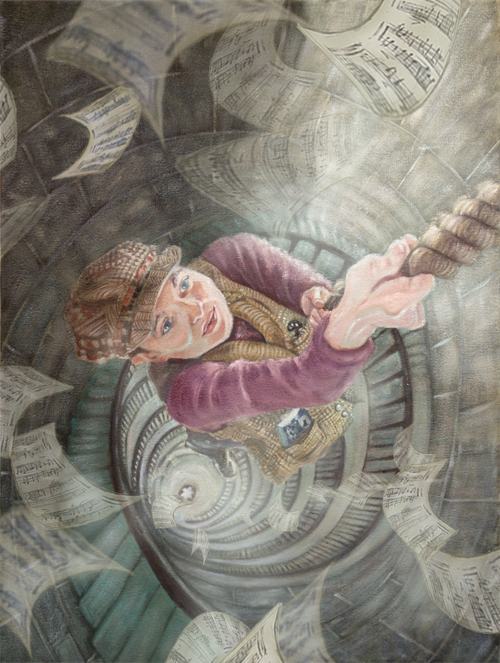
This exciting illustration was sent in by Amal Karzai. Amal was featured on Illustrator Saturday. Here is the Link.
Food for thought:
As writers, one of the questions we ask ourselves when we are reading our first draft is, “Is my main character sympathetic? What we are really asking is, “Have I written a character that the reader will want to root for?” “Will the reader feel what your character feels?” Will the reader understand the difficulties that face the MC and will the care?”
The goal is to create the fictive dream, to immerse the reader into the story’s world, but if we make our protagonist too snarky or whiny, even if they will grow during the book, the reader may not want to spend their time with the little brat and put down your book. You need to give the reader a glimpse of some redeeming quality. The MC could be in the middle of a meltdown, but the writer could show the MC unconsciously doing something nice during that scene. It could be as little as just stopping a glass of juice from falling off the table or keeping their little brother from slipping on the juice that has spread across the floor. By doing this you have shown the reader something good about the character and given them a reason to want to stay on the journey with him or her.
Just be careful not to go too much the other direction. If your MC is too perfect, the reader probably will not like him or her. Making your protagonist too perfect will make it almost impossible for reader to identify with them. Plus, it does not give the MC any room for a character arc and no need to grow and change. There needs to be flaws that the character can overcome.
The problem is not to go overboard. No one wants to read about a stupid person. No one wants to read about a major sad sack. Award winning author, Alicia Rasley says, “A passive victim doesn’t struggle – just suffers,” and “Defeat isn’t sympathetic. It’s pathetic.”
There are many ways to create sympathy for your characters, but just try to keep it fresh. Use a combination of strengths, struggles, and sacrifices. There are outer strengths, like physical and skills, and there are inner strengths, like perseverance, self-control, optimism, wit or humor, and integrity. Try to avoid old tired troupes.
Remember, you can show your character as lonely, disadvantaged, unpopular, unfulfilled, sad, and confused, but the reader doesn’t have to pity the character to identify with him.
Do you have any “food for thought” to add, that might help create a sympathetic character, while not making them feel stale? Any tips on making your characters interesting and someone the reader would like to spend time getting to know? We’d love to hear.
Talk tomorrow,
Kathy
Filed under:
Advice,
Author,
Character,
Process,
reference,
revisions,
Tips,
writing Tagged:
Amal Karzai,
Sympathetic Characters 


By: Kathy Temean,
on 5/27/2014
Blog:
Writing and Illustrating
(
Login to Add to MyJacketFlap)
JacketFlap tags:
Marketing a book,
Wheels of Change,
Darlene Beck-Jacobson,
Curriculum Guide Example,
Secon Industrial Revolution,
Women gaining independence,
reference,
inspiration,
Process,
Add a tag
WHEELS OF CHANGE CURRICULUM GUIDE
Introduce students to the Industrial Revolution at the turn of the Twentieth Century, using the book as a basis for discussions. This topic is part of the national learning standards and curriculum for U.S. History.
Topics for discussion:
- Introduce causes of the Industrial Revolution and how it changed the workplace and production of goods in America.
- Discuss handmade vs. factory made goods.
- Discuss good change vs. bad change and how it affects individuals and society.
- Discuss women’s emerging independence, their role in the workplace and at home, and how this affects the family.
Objectives:
- To understand the causes and effects of the Second Industrial Revolution (1890’s through WWI)
- To understand how progress has negative as well as positive consequences for individuals and society.
- To understand how even when some members of society benefit from changes, others may not.
- To witness a personal perspective to a period in our nation’s history.
Key Words/Concepts:
- Mass Production
- Assembly lines
- Women’s Suffrage
- Segregation/Prejudice
- Mechanization
Background:
The Industrial Revolution began in the late 1700’s through the 1840’s when goods formerly produced by hand began to be made with machines. Almost every aspect of daily life was influenced in some way. The second wave of industrialization occurred at the turn of the Twentieth Century and lasted until World War I. This revolution revolved around steel, railroad expansion, electricity, chemicals, and communication.
Mass production of steel replaced hand wrought iron. Blacksmiths – like Henry Johnson in WHEELS OF CHANGE – would no longer be needed to produce the rails, machine components and tools used to manufacture goods and move them from one place to another. Railroads replaced steamboats to transport goods over longer lasting steel rails. Electricity allowed factories to increase production of clothing and household goods. It also made it possible for Henry Ford to redesign the factory using tools and specialized machines positioned in a unique sequence to eliminate unnecessary human movement. The assembly line was born. More goods made in less time at a cheaper cost.
It took Mr. Soper weeks to make one of his carriages. It also took Henry days to hammer out all the iron needed to support the carriage body. The new factory system eliminated this labor-intensive process.
Part One: Making the topic relevant:
Begin a discussion on all the modern conveniences we all enjoy thanks to factory made products. When things get lost or broken we can easily and cheaply replace them.
Part Two: Read WHEELS OF CHANGE with students and start a discussion using the following topics:
- Why was Emily worried about automobiles coming to town? Was her worry real or imagined?
- How did having electricity and a telephone change life for Emily and her family?
- Emily’s mama had few modern appliances or household gadgets. How would having these things change her life?
- Why were some people upset when papa employed an African American blacksmith? How did prejudice impact some of the decisions actions taken in the story?
- Women could not vote and had few rights in 1908. Why do you think so many people were opposed to allowing women the right to vote?
- Why was the telegraph and mail service so important in the early 1900’s?
Concluding Activity: Have students write about what their lives would be like without electricity, telephones, or motor cars. Would some aspects of life be better without those things?
Or, have them write about prejudice and being judged by the color of your skin. Should groups be singled out based on ethnic origin, religion, or political beliefs? Where in the world are these things still taking place today?
Stop back on Sunday to view Darlene’s Study Guide.
Talk tomorrow,
Kathy
Further Study:
http://en.wikipedia.org/wiki/Second_Industrial_Revolution
www.ushistoryscene.com/uncategorized/secondindustrialrevolution/
Filed under:
inspiration,
Marketing a book,
Process,
reference Tagged:
Curriculum Guide Example,
Darlene Beck-Jacobson,
Secon Industrial Revolution,
Wheels of Change,
Women gaining independence 


By: Kathy Temean,
on 5/27/2014
Blog:
Writing and Illustrating
(
Login to Add to MyJacketFlap)
JacketFlap tags:
Wheels of Change,
Darlene Beck-Jacobson,
Curriculum Guide Example,
Secon Industrial Revolution,
Women gaining independence,
reference,
inspiration,
Process,
Marketing a book,
Add a tag
WHEELS OF CHANGE CURRICULUM GUIDE
Introduce students to the Industrial Revolution at the turn of the Twentieth Century, using the book as a basis for discussions. This topic is part of the national learning standards and curriculum for U.S. History.
Topics for discussion:
- Introduce causes of the Industrial Revolution and how it changed the workplace and production of goods in America.
- Discuss handmade vs. factory made goods.
- Discuss good change vs. bad change and how it affects individuals and society.
- Discuss women’s emerging independence, their role in the workplace and at home, and how this affects the family.
Objectives:
- To understand the causes and effects of the Second Industrial Revolution (1890’s through WWI)
- To understand how progress has negative as well as positive consequences for individuals and society.
- To understand how even when some members of society benefit from changes, others may not.
- To witness a personal perspective to a period in our nation’s history.
Key Words/Concepts:
- Mass Production
- Assembly lines
- Women’s Suffrage
- Segregation/Prejudice
- Mechanization
Background:
The Industrial Revolution began in the late 1700’s through the 1840’s when goods formerly produced by hand began to be made with machines. Almost every aspect of daily life was influenced in some way. The second wave of industrialization occurred at the turn of the Twentieth Century and lasted until World War I. This revolution revolved around steel, railroad expansion, electricity, chemicals, and communication.
Mass production of steel replaced hand wrought iron. Blacksmiths – like Henry Johnson in WHEELS OF CHANGE – would no longer be needed to produce the rails, machine components and tools used to manufacture goods and move them from one place to another. Railroads replaced steamboats to transport goods over longer lasting steel rails. Electricity allowed factories to increase production of clothing and household goods. It also made it possible for Henry Ford to redesign the factory using tools and specialized machines positioned in a unique sequence to eliminate unnecessary human movement. The assembly line was born. More goods made in less time at a cheaper cost.
It took Mr. Soper weeks to make one of his carriages. It also took Henry days to hammer out all the iron needed to support the carriage body. The new factory system eliminated this labor-intensive process.
Part One: Making the topic relevant:
Begin a discussion on all the modern conveniences we all enjoy thanks to factory made products. When things get lost or broken we can easily and cheaply replace them.
Part Two: Read WHEELS OF CHANGE with students and start a discussion using the following topics:
- Why was Emily worried about automobiles coming to town? Was her worry real or imagined?
- How did having electricity and a telephone change life for Emily and her family?
- Emily’s mama had few modern appliances or household gadgets. How would having these things change her life?
- Why were some people upset when papa employed an African American blacksmith? How did prejudice impact some of the decisions actions taken in the story?
- Women could not vote and had few rights in 1908. Why do you think so many people were opposed to allowing women the right to vote?
- Why was the telegraph and mail service so important in the early 1900’s?
Concluding Activity: Have students write about what their lives would be like without electricity, telephones, or motor cars. Would some aspects of life be better without those things?
Or, have them write about prejudice and being judged by the color of your skin. Should groups be singled out based on ethnic origin, religion, or political beliefs? Where in the world are these things still taking place today?
Stop back on Sunday to view Darlene’s Study Guide.
Talk tomorrow,
Kathy
Further Study:
http://en.wikipedia.org/wiki/Second_Industrial_Revolution
www.ushistoryscene.com/uncategorized/secondindustrialrevolution/
Filed under:
inspiration,
Marketing a book,
Process,
reference Tagged:
Curriculum Guide Example,
Darlene Beck-Jacobson,
Secon Industrial Revolution,
Wheels of Change,
Women gaining independence 

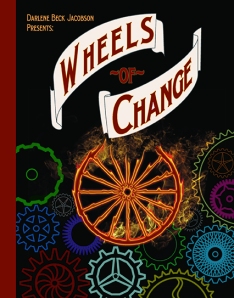 A few weeks ago I was out with Darlene Beck Jacobson and she started talking about the work she was doing to develop a curriculum and study guide for her debut book that is coming out in September.
A few weeks ago I was out with Darlene Beck Jacobson and she started talking about the work she was doing to develop a curriculum and study guide for her debut book that is coming out in September.
I asked her to share what she was doing with all of you, since we can all learn from each other. Here is part one of the three part series.
TYING YOUR NOVEL INTO THE CORE CURRICULUM By Darlene Beck Jacobson
Schools are changing. So are the curriculum requirements. With teachers being squeezed for time and tight budgets limiting purchases of “frivolous” things like fiction for the classroom, what can we writers do to give our books a fighting chance on classroom reading lists?
You can develop a CURRICULM GUIDE and STUDY QUESTIONS to tie into the Core Curriculum Content Standards. For my historical middle grade novel WHEELS OF CHANGE, which takes place in 1908 Washington DC, I developed a curriculum guide on the second wave of the Industrial Revolution. (see attached)
I also did a separate set of Study Questions that tie into Reading and Literature objectives. (see attached) You can do the same thing for your novel…even if it isn’t historical. Begin by generating questions that fit the Reading and Literature sections of the standards. Then look for the universal theme or ideas that would generate good classroom discussions on topics that cover important issues such as war, homelessness, divorce, illness, poverty, prejudice, etc. These topics can be part of Science, Health, and Social Studies units. Fellow writers have even tied their books into art and music areas as well.
You can also develop worksheets, puzzles, games or other reproducible activity sheets that teachers can use in the classroom. Everything you can do to make life easier for a teacher, will help make your book stand out from all the others that cry for attention in the curriculum.
To learn more about Common Core Standards visit: www.commoncorestandards.org
PART II: Curriculum Guide tomorrow
Darlene Beck Jacobson has loved writing since she was a girl. She also loves bringing the past to life in stories such as WHEELS OF CHANGE (Creston Books), her debut novel. Her stories have appeared in CICADA, CRICKET, and other magazines. Her blog features recipes, activities, crafts and interviews with children’s book authors and illustrators. She still loves writing and getting letters. Check out her website at: http://www.darlenebeckjacobson.com
WHEELS OF CHANGE is due out on September 22, 2014.
Talk tomorrow,
Kathy
Filed under:
article,
How to,
reference Tagged:
Common core Guidelines,
Curriculum Guide,
Darlene Beck-Jacobson,
Study Guide,
Wheels of Change 


By: Kathy Temean,
on 4/13/2014
Blog:
Writing and Illustrating
(
Login to Add to MyJacketFlap)
JacketFlap tags:
reference,
Queries,
How to,
demystify,
Carol Schulman,
Leslie Zampettis,
Links to resources,
Rear in Gear,
Writing Tips,
list,
Add a tag

This illustration of the cute girl with pink glasses above was sent in by Carol Schulman. She is the author of two books on art, both now represented by Schulman Literary in NY. The first, “The Creative Path: Process and Practice” is a look at creativity from philosophical, psychological and practical points of view. The sequel: “Art Smarts: A Book to Help You Become a GR8 Artist” is a sequel for children. See more at: http://www.carolynschlam.com/Art_Pages/Illustration/Illustration_info.html
Leslie has been focusing on querying agents and looking for places that had good information about navigating this process. She decided to share some resources she gathered from various writing friends on her blog “Rear in Gear”. She says, “I’m always thankful for their help, and thought I’d pay it forward in a small way.”
Queries Not Questions
Here is Leslie’s list, in no particular order:
AgentQuery
Chuck Sambuchino’s Guide to Literary Agents
Successful Queries (a subsection of the above guide)
Preditors and Editors
Publishers’ Submission Guidelines
JacketFlap
SCBWI BlueBoard
8 Steps to Finding the Right Agent
Critiquing First Pages and Queries
10 Questions to Ask an Agent
Kidlit.com – Queries
How to Write the Perfect Query Letter
Query Shark
Query Tracker
Writers Market *This is a subscription service. IMHO, well worth it.
Children’s Writer Newsletter *Another subscription service. Articles often contain market bib biographies, and every issue contains market profiles. Also well worth it.
-
 Leslie Zampetti has had stories published in online children’s magazines and is now querying agents for her middle grade fantasy novel. A childhood spent in Florida has this transplanted New Yorker frequently dreaming of sunshine – but she enjoys the whirl of the city and its riches, not least of which is the New York Public Library.
Leslie Zampetti has had stories published in online children’s magazines and is now querying agents for her middle grade fantasy novel. A childhood spent in Florida has this transplanted New Yorker frequently dreaming of sunshine – but she enjoys the whirl of the city and its riches, not least of which is the New York Public Library.
According to most successful authors, the best way to succeed is to plant your tushy in your seat and write. Leslie’s been doing that for some years now and is beginning to see the seeds of her labor blossom. Interested in knowing more? Stop by her blog, “Rear in Gear,” at http://zampettilw.wordpress.com.
Thank you Leslie to sending this to me. It is nice to have a list and it is nice that you were willing to share the wealth. I am sure everyone will bookmark this one.
Talk tomorrow,
Kathy
Filed under:
demystify,
How to,
list,
reference,
Writing Tips Tagged:
Carol Schulman,
Leslie Zampettis,
Links to resources,
Queries,
Rear in Gear 


By: Kathy Temean,
on 3/29/2014
Blog:
Writing and Illustrating
(
Login to Add to MyJacketFlap)
JacketFlap tags:
list,
reference,
Advice,
Editors,
organizations,
authors and illustrators,
Publishing Industry,
opportunity,
need to know,
Books by Editor,
SCBWI Benefits,
Add a tag
Are you using all your SCBWI member benefits? I bet there are a lot of busy writers who are missing a lot of things that the SCBWI provides to help you sell your manuscripts. Did you know if you are a member and login to www.scbwi.org, you can find a list of editors and what books they edited? This is valuable information when trying to find the right home for something you have written.
A smart writer or illustrator (they list picture books with the illustrators) would save this file and every time they read a book, they would look in the author credits to see if they mentioned who helped them make their book shine. If they are smart, they will mention the editors at the publishing company as a way to thank them for their expertise. We can use that information to hone our submissions and use that information in a query letter or when we run into an editor. This is called, “doing your homework” and makes you appear as someone who knows the industry.
Below is just part of one page to give you an idea of what it looks like.
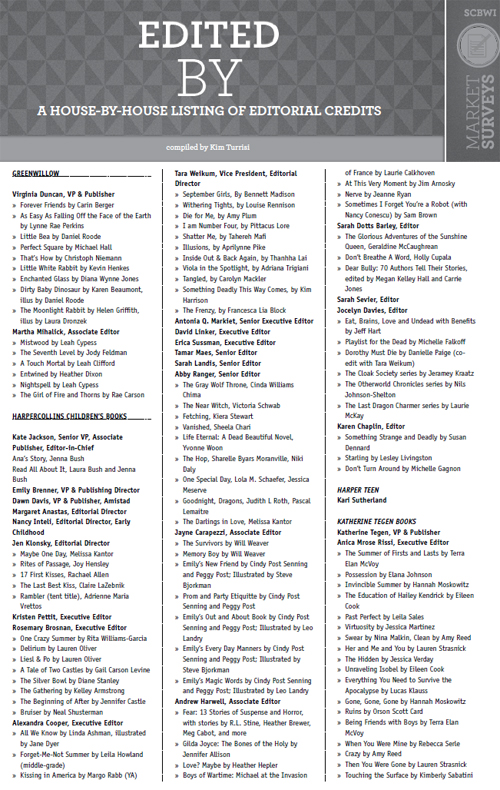
Hope you take the time to check out all the benefits your SCBWI membership provides.
Talk tomorrow,
Kathy
Filed under:
Advice,
authors and illustrators,
Editors,
list,
need to know,
opportunity,
organizations,
Publishing Industry,
reference Tagged:
Books by Editor,
SCBWI Benefits 


By: Kathy Temean,
on 3/25/2014
Blog:
Writing and Illustrating
(
Login to Add to MyJacketFlap)
JacketFlap tags:
Writing Tips,
reference,
Advice,
Process,
David Diaz,
How to,
Query Tips,
Sylvia Liu,
Links to Query letter Info,
New Voices Award Winner,
Query letter Example,
Add a tag
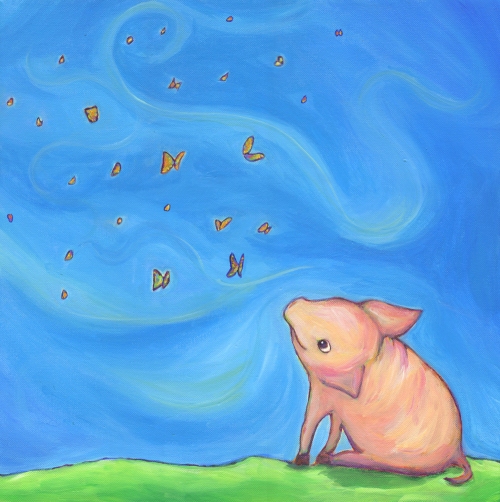
This cute little piggy was sent in by Sylvia Liu. Sylvia was selected the 2013 New Voices Award winner by Lee and Low Books and my debut picture book, A MORNING WITH GONG GONG, is scheduled to be published in Fall 2015. She is part of the 2013 Nevada SCBWI Mentor Program and being mentored in illustration by Caldecott-winner David Diaz.
TIPS:
1. Always address your query to a specific person.
2. Make sure you mention the title of your book in third paragraph.
3. Mention the word count and genre of your book in third paragraph.
Note: Novels should be 80,000 to 100,000 words. Young adult novels can be significantly less: 40,000-60,000 words. Insert word count and genre at the end of your first “hook” paragraph.
If your novel is 200,000 words – Cut before you query. No one wants an overweight manuscript. AgentQuery reports unless your manuscript is a historical family saga or an epic science fiction battle, agents hit DELETE on proposed first-time novel over 110,000-120,000 words.
4. Share the reason why you are querying this particular agent. Let the agent know that you have researched them and have a reason for choosing them for representation.
5. Have someone you know check for typos and grammar mistakes. It is very easy when e-mailing a query letter to click the send button before throughly checking your text. Writers seem to be in the mode to triple check everything when they snail mail their queries, but since we send so many personal e-mails without closely checking every word, that “Send” button can be easily clicked. The mistake snail mailing query writers make is forgetting to include their contact information – something you don’t need to include with an e-mail. I know that sounds crazy, but I have seen it when writers have sent me submissions for editors and agents.
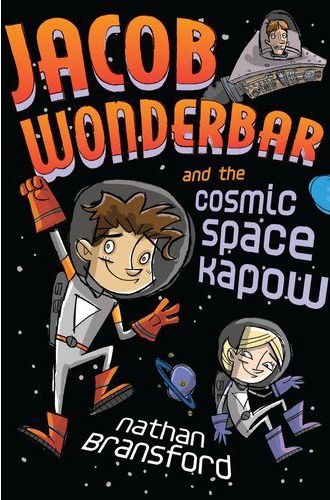 Need to see an ACTUAL query letter before you’ll know how to write one? Here is the query letter Author (at the time agent) Nathan Bransford:
Need to see an ACTUAL query letter before you’ll know how to write one? Here is the query letter Author (at the time agent) Nathan Bransford:
Dear Ms. Drayton,
As a young literary agent with Curtis Brown Ltd. I have long admired Inkwell, as well as your strong track record. To paraphrase Douglas Adams, if you searched for a book that was almost, but not quite, entirely unlike THE BOOK THIEF (which I absolutely loved), you might just have JACOB WONDERBAR AND THE COSMIC SPACE KAPOW, a middle-grade-and-up science fiction novel that I just completed. Still fun! But no one dies – Mr. Death would be lonely.
Jacob Wonderbar has been the bane of every substitute teacher at Magellan Middle School ever since his dad moved away from home. He never would have survived without his best friend Dexter, even if he is a little timid, and his cute-but-tough friend Sarah Daisy, who is chronically overscheduled. But when the trio meets a mysterious man in silver one night they trade a corn dog for his sassy spaceship and blast off into the great unknown. That is, until they break the universe in a giant space kapow and a nefarious space buccaneer named Mick Cracken maroons Jacob and Dexter on a tiny planet that smells like burp breath. The friends have to work together to make it back to their little street where the houses look the same, even as Earth seems farther and farther away.
JACOB WONDERBAR AND THE COSMIC SPACE KAPOW is 50,000 words and stands alone, but I have ideas for a series, including titles such as JACOB WONDERBAR FOR PRESIDENT OF THE UNIVERSE and JACOB WONDERBAR AND THE VACATIONING ALIENS FROM ANOTHER PLANET. I’m the author of an eponymous agenting and writing blog.
I’d be thrilled if you would consider WONDERBAR for representation, and a few other agents are considering simultaneously. Thanks very much, and hope to talk to you soon.
Nathan Bransford
Here are a few other places to look:
Nathan Bransford dissects a really good query letter and extoll its virtues.
Click Here to Visit Galleycat. They have 23 Agent Query Letters That Actually Worked.
Nonfiction writers don’t need to have a completed manuscript. They only need a proposal before seeking representation from an agent. Here’s are books and places to help with writing a proposal:
Talk tomorrow,
Kathy
Filed under:
Advice,
How to,
Process,
reference,
Writing Tips Tagged:
David Diaz,
Links to Query letter Info,
New Voices Award Winner,
Query letter Example,
Query Tips,
Sylvia Liu 


By: Kathy Temean,
on 3/24/2014
Blog:
Writing and Illustrating
(
Login to Add to MyJacketFlap)
JacketFlap tags:
Agent,
Writing Tips,
reference,
Advice,
Process,
Noah Lukeman,
How to write a query letter,
How to,
Breaking down the Query Letter,
One page Query letter,
Add a tag
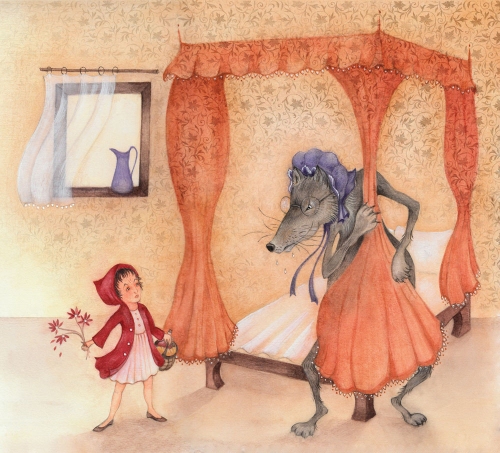
You can see from the above illustration by Evi Gstottner that she loves fairytales and folktales. She graduated in 1992 from Byam Shaw School of Art in London and in 2009 she completed her MA in Children’s Book Illustration at the Anglia Ruskin University (Cambridge School of Art). Evi was featured on Illustrator Saturday. Here is the link: http://www.kathytemean.wordpress.com/2013/03/23/illustrator-saturday-evi-gstottner/
The goal of query letter is to elicit an invitation from an agent (or editor) to send in sample chapters or the whole manuscript.
A query letter is a ONE PAGE letter with three concise paragraphs: the hook, the mini-synopsis, and your writer’s biography.
Don’t stray, if you want to be taken seriously as a professional writer. Keep it simple. Stick to three paragraphs.
Paragraph One is called The Hook: A hook is a concise, one-sentence tagline for your book. It’s meant to hook your reader’s interest, and reel them in.
The first paragraph is your chance (perhaps your only chance) to grab the agent, since many agents will be immediately biased—for good or for bad—within a sentence or two.
If a writer queries via a referral, he will always begin with, “I am writing to you because your client, John Smith, recommended that I do so.” Thus an agent, whether he likes it or not, must take the first sentence seriously, if for no other reason than he risks offending an existing client check or editor. Please do not say this unless it is true. Agents will check and you don’t want to be embarrassed or have someone think you are not trustworthy.
If you haven’t been referred, you could still grab the agents attention with something personal., such as: ”I am writing to you because you represented TITLE by AUTHOR, and I feel my book is similar.”
What will this show?
1. That this is not a random query letter.
2. That you’re approaching him/her for a specific reason
3. That you’ve put a great deal of time and energy into researching the market
4. That you know who the agent represents, and the types of books they have sold.
5. It will put a positive association into the agents mind, as it will make him or her think of a book they sold.
6. It offers a comparison, allowing the agent to immediately grasp the type of book you’re writing and thus help they agent decide if they want to represent another like it.
7. It shows that you know the market, that you have an objective grasp of what your own book is about and where it fits within that market.
8. It indicates that you’ve put care into your writing.
Referencing one of his/her titles will help accomplish this. But don’t bluff. Noah says, ”If you don’t truly do the research, it will show. I’ve received many letters which referenced a book I sold, but when I read the rest of the query, I realized that their book was not at all similar; it was just a gimmick to get me to pay attention. When an agent realizes this, he will just be annoyed. So when referencing a book, make sure it is truly appropriate. But if you’ve done the research and query a truly appropriate agent and reference a truly appropriate title, then you are already off to a shining head start.”
Agent Query suggests using the when formula: “When such and such event happens, your main character—a descriptive adjective, age, professional occupation—must confront further conflict and triumph in his or her own special way. Sure, it’s a formula, but it’s a formula that works.”
Example: Bridges of Madison County
When Robert Kincaid drives through the heat and dust of an Iowa summer and turns into Francesca Johnson’s farm lane looking for directions, the world-class photographer and the Iowa farm wife are joined in an experience that will haunt them forever.
Note: Many writers use the “when” formula, so use it as a starting point. Write your basic hook and then spice it up with the “When. Noah says to keep your opening paragraph to one sentence, so if you add a when to the personal approach, make sure it is short.
Example: Non-”formulatic” fiction hook:
The Da Vinci Code A murder in the silent after-hour halls of the Louvre museum reveals a sinister plot to uncover a secret that has been protected by a clandestine society since the days of Christ.
Paragraph Two—Mini-synopsis: This is where boil down your entire novel into one paragraph and expand your hook. Put in the hard work of practicing and revising, until you get that paragraph to sing the same tune as your whole book. Read the back flap of books you like to get a feel for how to create a juicy paragraph.
Paragraph Three—Writer’s bio: Keep it short and related to writing. If your book revolves around a hospital and you are a nurse, then say that. If you have a published book, been published in some magazines, etc,, or won a writing contest or award, then let the agent know. if you’ve never been published, never won any awards, hold no writing degrees, and have no credentials to write your book, then don’t say it. This just gives you more space for Paragraph Two.
The Closing: Thank the agent for their time and consideration. Let the agent know you have the full manuscript available upon request. Note: Never query an agent unless you have written, revised, and finished your full manuscript.
Tomorrow: Query Tips – Examples and Links.
Talk tomorrow,
Kathy
Filed under:
Advice,
Agent,
How to,
Process,
reference,
Writing Tips Tagged:
Breaking down the Query Letter,
How to write a query letter,
Noah Lukeman,
One page Query letter 


By: Kathy Temean,
on 3/23/2014
Blog:
Writing and Illustrating
(
Login to Add to MyJacketFlap)
JacketFlap tags:
Process,
need to know,
demystify,
Agent Noah Lukeman,
The goal of the Query Letter,
The Query Letter,
What a query letter says about you,
Agent,
Writing Tips,
reference,
Advice,
Add a tag
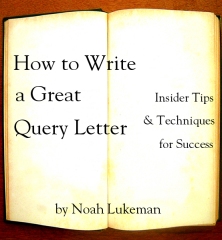 For the last few weeks we have gone over how to format your manuscript and how to write a synopsis. Every week I have pointed you towards agents and what they are looking for, but really the first thing you need to do is hone your skills on writing a great query letter. It is wonderful that more and more agents are accepting query letters via email, but there a perils that come along with this. We are so used to quickly jotting down a few sentences to talk with friends and hitting the send button without thinking, that the same thing can happen when emailing a query letter to an agent. We all need to beware of doing this an approach the query letter with the same respect as the rest of our writing.
For the last few weeks we have gone over how to format your manuscript and how to write a synopsis. Every week I have pointed you towards agents and what they are looking for, but really the first thing you need to do is hone your skills on writing a great query letter. It is wonderful that more and more agents are accepting query letters via email, but there a perils that come along with this. We are so used to quickly jotting down a few sentences to talk with friends and hitting the send button without thinking, that the same thing can happen when emailing a query letter to an agent. We all need to beware of doing this an approach the query letter with the same respect as the rest of our writing.
Agent Noah Lukeman has written a whole book on how to do this in his appropriately title book, HOW TO WRITE A GREAT QUERY LETTER.
Love the way Noah explains this: Most writers put a tremendous amount of effort into their content, spending months or years with their manuscripts, agonizing over word choice, scene order, character development. Yet when it comes time to write a query letter, they will often write something off the top of their head, sometimes with a mere hour’s effort, and let this suffice to represent their work. They rush through the letter process so that the agent can get to the book itself, which they feel will explain everything. They feel that if an agent just sees the writing, nothing else will matter, and that a poor query letter will even be forgiven. This is faulty thinking. For agents, the query letter is all. If it’s not exceptional, agents will not even request to see the writing, and writers will never even get a chance to showcase their talent. For most writers, the query letter—which they rushed through—becomes the only piece of writing they will ever be judged by, and unfortunately, the only chance they ever had. While it may seem as if a query letter is a shallow way to judge an author, I can tell you from an agent’s perspective that it is a very effective tool.
For the professional eye, a query letter is much more than just a letter:
1. It shows the agent whether you are able to exhibit word economy
2. Whether you have a grasp on the nature of your own work
3. Whether you have a realistic grasp on your own background and credentials.
4. For non-fiction: It also demonstrates whether you have a grasp on your market and your competition. A query letter can also serve to warn an agent, to act as a red flag, if for example you are too aggressive, or pitch too many projects at once. The way it physically looks speaks volumes, as does whether you’ve sent it to the right person in the right way. A layman looks at a query and sees a one page letter. An agent looks at it and scans it for 100 different criteria.
This mere page can tell an agent more about the writer and his work than you can possibly imagine.
This week we will talk about what goes into making your query letter stand out and get noticed. Remember: The query letter might be the only thing that agent ever reads of your writing. Remember: Agents have a big pile of other writer’s query letters sitting in front of them and would like to get through that pile sitting on their desk, so small things can be the difference between them saying, “Send more” and “not interested.” But also, Remember: Agents want to find the next great book or else they wouldn’t be facing that pile.
So let’s learn what to do, learn how to avoid the pitfalls that get our letter tossed and signal an amateur.
Noah Lukeman is giving away a .pdf of this book and How to Land an Agent. You can also get it for free on your Kindle at Amazon.
Here is the link for the download: http://www.landaliteraryagent.com/
Here is the layout for this week:
Tuesday: HOW TO WRITE A QUERY LETTER.
Wednesday: Query Letter Tips – Examples and Links
Thursday: Agent Wishlist
Friday: First Page Critique Results
Talk tomorrow,
Kathy
Filed under:
Advice,
Agent,
demystify,
need to know,
Process,
reference,
Writing Tips Tagged:
Agent Noah Lukeman,
The goal of the Query Letter,
The Query Letter,
What a query letter says about you 


By: Kathy Temean,
on 3/19/2014
Blog:
Writing and Illustrating
(
Login to Add to MyJacketFlap)
JacketFlap tags:
How to,
demystify,
Australian Illustrator,
Celcilia Clark,
Synopsis Checklist,
Synopsis evaluation,
Writing Tips,
list,
reference,
Process,
Add a tag

This illustration my Cecilia Clark gives us a glimpse of what awaits us after this long cold winter. Cecilia is a budding writer and illustrator from Australia. Her writing and illustrating has been published in anthologies. She is a member of SCBWI Australia and New Zealand(Society of Children’s Book Writers and Illustrators) the Fellowship of Australian Writers (FWA) and Romance Writer’s Australia(RWA). http://ceciliaaclark.blogspot.com.au
Synopsis Checklist:
1. Is your synopsis between one and three pages? Double spaced if more than one page?
2. Does the opening paragraph have a hook to keep the editor or agent reading?
3. Did you use capital letters the first time you introduced a character?
4. Did you show your characters goal, motivation, conflict, and growth?
Your synopsis should give a clear idea as to what your book is about, what characters we will care about (or dislike), what is at stake for your heroes, what they stand to lose, and how it all turns out.
5. Have you hit on the major scenes, the major plot points of your book, and include the ending?
6. How you gotten to the who, what, where, when and why in your synopsis?
7. Do you keep the interest level up throughout the synopsis?
8. Is there good flow between paragraphs.
9. Have you avoided all grammar, spelling, and punctuation mistakes?
10. Do you think you captured the flavor of your manuscript?
See yesterday’s post for synopsis details.
Talk tomorrow,
Kathy
Filed under:
demystify,
How to,
list,
Process,
reference,
Writing Tips Tagged:
Australian Illustrator,
Celcilia Clark,
Synopsis Checklist,
Synopsis evaluation 


By: Kathy Temean,
on 3/18/2014
Blog:
Writing and Illustrating
(
Login to Add to MyJacketFlap)
JacketFlap tags:
Process,
How to,
Doris Ettlinger,
Rhode Island School of Design,
demystify,
Synopsis Format,
Synopsis Guide,
Tips,
list,
reference,
Add a tag
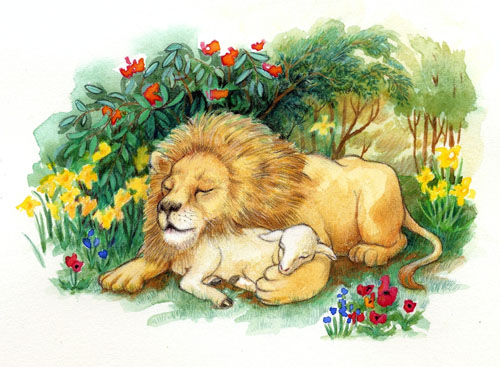
Doris Ettlinger sent in this gorgeous illustration reminding us of how March comes in as a lion and goes out like a lamb. Doris graduated from the Rhode Island School of Design and received an MFA from the University of Wisconsin – Madison. She was featured on Illustrator Saturday in 2010: http://kathytemean.wordpress.com/2010/07/17/illustrator-saturday-doris-ettlinger/
After talking about formatting your manuscripts, it was logical to receive a few emails asking about how to format a synopsis. That lead to adding other things you need to consider when writing one for your novel.
How to format your synopsis.
Use a one inch margins on the top, bottom and sides. Justify text at the left margin only. Use Times New Roman 12 pt. font. Type your name, address, phone number, fax number and e-mail address, each on a separate line single-spaced at the top left margin on the first page of your synopsis.
If you can fit your synopsis on one page, then you can single space the text with a space between paragraphs . If it goes over one page, then double space your text. Editors generally want one or two pages, but if you must go longer than you must – just keep it tight. You should always check a publisher’s submission guidelines, just to make sure you are following their rules before submitting.
Here are some things to help guide you through the synopsis writing process:
• You want to briefly tell what happens. This is one place you can ignore Show, Don’t Tell.
• Your goal should be to give an escalating series of turning points, a strong central crisis, a dramatic climax and a satisfying resolution.
• Introduce your main character first. Type a character’s name in all CAPS the first time you use it in the synopsis. Why? It helps the editor remember or find your character names.
• Remember your synopsis should showcase your unique voice.
• The synopsis should reflect your story. If it is humorous, be funny, etc.
• Start with a hook.
• Use present tense. This gives the story immediacy.
• Write the high points of your story in chronological order. Keep these paragraphs tight.
• Always answer basic who, what, where, when, why–early in the synopsis.
• Don’t waste words or time describing settings, unless crucial. Sometimes it’s enough just to put the date and place at the top, then start your synopsis.
• Omit unimportant details.
• Only include backstory if it is necessary to give the editor the information they need about the character’s motives.
• Always resolve the external plot question before you resolve the internal and/or relationship question.
• If it’s not a turning point, it doesn’t belong in the synopsis.
• Don’t use secondary characters in your synopsis, unless they are absolutely critical to the emotional turning points of the relationship. Even then, try to get by with the using the secondary’s relationship to the major characters (sister, teacher, boss.) They are too hard to keep up with and only add clutter. Only name them when necessary.
• Clearly convey the central question of the story, and what the resolution looks like. And resolve it at the end — don’t leave the editor guessing. They hate that, so spell out the story, including the ending.
• Rewrite your synopsis until each sentence is polished to the point of perfection. Use strong adjectives and verbs. Make every word count.
Check back tomorrow for a synopsis checklist you can use when drafting one for your manuscript.
Talk tomorrow,
Kathy
Filed under:
demystify,
How to,
list,
Process,
reference,
Tips Tagged:
Doris Ettlinger,
Rhode Island School of Design,
Synopsis Format,
Synopsis Guide 


By: Kathy Temean,
on 3/10/2014
Blog:
Writing and Illustrating
(
Login to Add to MyJacketFlap)
JacketFlap tags:
Writing Tips,
Book,
reference,
inspiration,
Advice,
Writer's Digest,
demystify,
Description in Your Writing,
Rebecca Mcclanahan,
Word Painting,
Add a tag
 Some of us try to use description language too much in our writing and others need to start thinking about how to use this literary tool more often.
Some of us try to use description language too much in our writing and others need to start thinking about how to use this literary tool more often.
The dictionary defines “describe” as:
To transmit a mental image or impression
To trace or draw the figure of; to outline
To give a verbal account of; to tell about in detail
Used properly it can take your reader into your fictional dream and that is a good thing.
I just bought Word Painting by Rebecca Mcclanahan and thought I would share some of the things she talks about in the first chapter that should give you food for thought. Like I said I just bought it, but so far I am glad I added it to my “How to” books.
1. Descriptive passages create the illusion of reality, inviting the reader to move in, unpack, and move in for a spell. They provide verisimilitude. What John Gardner (author of The Art of Fiction) calls the “proofs” that support and sustain your fictional dream. It is not a bunch of “flowery stuff.” It is not just something we stitch on top of our writing to make it more presentable.
2. Description composed of sensory detail penetrates layers of consciousness, engaging your reader emotionally as well as intellectually. The success of all fiction depends in part on descriptive image-making power.
3. Carefully selected descriptive details can establish you characters and setting quickly and efficiently. It is not merely describing how something looks with visual detail, but also smells, tastes, textures, and sounds.
4. As a framing device, description establishes the narrator’s, or character’s point of view. Shifts in the description frame (or eye) can signal shifts in point of view or a significant change in the character. Description begins in the eye, ear, mouth, nose, and hand of the beholder. Careful and imaginative observation may well be the most essential task of any writer.
5. Well-placed descriptive passages can move your story along, shape the narrative line and unfold the plot. It is not a way to hide from the truth. The world isn’t always pretty. Describe it honestly and face difficult, even ugly, subjects when necessary.
6. Descriptive passages can act as gearshifts, changing the pace of your story – speeding it up or slowing it down, then increasing the story’s tension.
7. Description can serve as a transitional device, a way of linking scene or changing time and place.
8. Description can orchestrate the dance between scene and summary.
9. Description can serve as a unifying thematic device, what Stanley Kunitz calls the “constellation of images” that appears and reappears in a literary work, suggesting the idea or feeling that lives beneath the story line.
10. Description can provide the palette of gradations in mood and tone. Dip you brush in one description and the darkens; in another, and the sun breaks through.
11. The language of you descriptions, its rhythms and sounds, can provide the equivalent of a muscial score for the fictional dream, a subliminal music that plays beneath the story line.
12. Writing descriptively doesn’t always mean writing gracefully. It won’t necessarily make our writing more refine, lyrical, or poetic. Some descriptions demand uneven syntax and plainspoken, blunt prose. Jagged, even. Fragments, too. Slice of chin. Buzz saw.
13. Description doesn’t always require a bigger vocabulary. House is probably a better choice than domicile, a horse is easier to visualize than an equine mammal, and red blood is brighter than the sanguine flow of bodily fluids.
14. Writing descriptively doesn’t necessitate writing more. Description isn’t a steroid, something to make our language bigger and stronger, nor is it an additive promising more miles to the fictional gallon. Sometimes writing descriptively means writing less or disappear altogether.
15. Description rarely stands alone. It should be woven in and seamlessly intertwined with other literary elements. Description isn’t something we simply insert, block style, into passages of narration or exposition. Yes, sometimes we write passages of description. But the term passage suggests a channel, a movement from one place to another; it implies that we’re going somewhere. That somewhere is the story.
Hope this helps.
Talk tomorrow,
Kathy
Filed under:
Advice,
Book,
demystify,
inspiration,
reference,
Writing Tips Tagged:
Description in Your Writing,
Rebecca Mcclanahan,
Word Painting,
Writer's Digest 


By: Kathy Temean,
on 3/9/2014
Blog:
Writing and Illustrating
(
Login to Add to MyJacketFlap)
JacketFlap tags:
authors and illustrators,
How to,
demystify,
The First Five Pages,
Formatting your manuscript,
Staying out of the Rejection Pile,
Writing Tips,
Book,
reference,
inspiration,
Advice,
Noah Lukeman,
rejection,
Add a tag
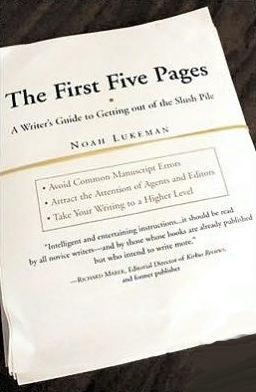 We’ve been talking a lot about how to format your manuscript, so I bought The First Five Pages: A Writers Guide To Staying Out of the Rejection Pile by Noah Lukeman to see what other things might be good to share and already he has reminded me of things I forgot to mention to you that you should do before submitting.
We’ve been talking a lot about how to format your manuscript, so I bought The First Five Pages: A Writers Guide To Staying Out of the Rejection Pile by Noah Lukeman to see what other things might be good to share and already he has reminded me of things I forgot to mention to you that you should do before submitting.
He says, “There are no rules to assure great writing, but there are ways to avoid bad writing.” He also points out that agents and editors don’t read manuscripts to enjoy them; they read solely with the goal of getting through the pile, solely with an eye to dismiss a manuscript.
So obviously, we want to do everything to look good and make our first contact a professional one. We want to make sure our manuscripts do not signal carelessness, sloppiness, ignorance, or defiance of the industry’s standards; that the writer doesn’t care enough to do the minimum amount of research to make a manuscript industry presentable. An editor or agent will assume that the careless presentation continues in the manuscript.
Avoid rejection in the first few minutes by making sure your manuscript is presented properly:
Paper: 8 1/2 x 11 inch standard 20 pound bond white computer paper.
Text: 12 pt. Times New Roman font. Printed only on one side of the page.
Clean: Do not send out a manuscript that you have sent out to other agents or editors if it appears the slightest bit worn.
Eliminate: Make sure you do not send out a manuscripts filled with boldface, underlined, capitalized, or italicized words everywhere, unless you purposely want to drive the agent or editor crazy.
Printing: Do not try to squeeze the last drops of ink from your printer and send out dim/hard to see and please if anyone still has a dot-matrix printer, throw it out and buy an ink-jet or laser printer.
Spacing: Double spaced lines with 1 inch margins. New paragraphs should be indented and also dialog should always be indented. Make sure you indent enough spaces (8-10 spaces on my computer). Nothing is worse than trying to read a manuscript when the indentations are so slight it is easy to miss them. Leave a half of a page between chapters. Line breaks between paragraphs scream amateur.
Do Not Include: Artwork or illustrations throughout the pages. It screams amateur. You might feel that adding some clip art helps the editor or agent get a feel for what you book is really about, but it is not professional. If you text needs a picture to explain what is going on, then add an illustrator’s note. Try to keep them to a minimum.
If you are an illustrator and have written and illustrated your book and have a book dummy; make sure you mention this in your query and give a website link where they can visit to see your art. You might want develop a page on your website exclusively to give to editors/agents, so they could view it online. Never send in original art.
Rights: When you present a manuscript to an agent or editor you are offering all rights. Do not put “Copyright” on your manuscript. It makes you look paranoid and besides it is not necessary.
Avoid Overuse of: Question marks, exclamation points, and parentheses. The abundant use of foreign words or phrases. Noah also say to avoid the inappropriate use of fancy words; crude of vulgar language or images; graphic blood and sex, but most of all cliché. Doing this in the first five pages can lead to instant rejection.
I think this covers all of the instant cosmetic rejections. Hope this helps.
Talk tomorrow,
Kathy
Filed under:
Advice,
authors and illustrators,
Book,
demystify,
How to,
inspiration,
reference,
rejection,
Writing Tips Tagged:
Formatting your manuscript,
Noah Lukeman,
Staying out of the Rejection Pile,
The First Five Pages 


By: Kathy Temean,
on 9/22/2013
Blog:
Writing and Illustrating
(
Login to Add to MyJacketFlap)
JacketFlap tags:
Writing Tips,
Book,
reference,
writing,
Advice,
Writer's Digest Books,
Jessica Page Morrell,
demystify,
Bullies Bastards & Bitches,
Add a tag
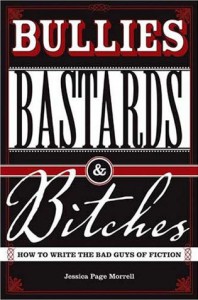
Bullies, Bastards & Bitches
How to Write the Bad Guys of Fiction
by Jessica Page Morrell
Writer’s Digest Books, 2008
ISBN 978-1-58297-484-2
$16.99 paperback, 304 pages
Amazon | BN.com :
- Here are some general differences between a hero and an anti-hero, and how an anti-hero is the antithesis of a traditional hero from:
- A hero is an idealist.
- An anti-hero is a realist.
- A hero has a conventional moral code.
- An anti-hero has a moral code that is quirky and individual.
- A hero is somehow extraordinary.
- An anti-hero can be ordinary.
- A hero is always proactive and striving.
- An anti-hero can be passive.
- A hero is often decisive.
- An anti-hero can be indecisive or pushed into action against his will.
- A hero is a modern version of a knight in shining armor.
- An anti-hero can be a tarnished knight, and sometimes a criminal.
- A hero succeeds at his ultimate goals, unless the story is a tragedy.
- An anti-hero might fail in a tragedy, but in other stories he might be redeemed by the story’s events, or he might remain largely unchanged, including being immoral.
- A hero is motivated by virtues, morals, a higher calling, pure intentions, and love for a specific person or humanity.
- An anti-hero can be motivated by a more primitive, lower nature, including greed or lust, through much of the story, but he can sometimes be redeemed and answer a higher calling near the end.
- A hero is motivated to overcome flaws and fears, and to reach a higher level. This higher level might be about self-improvement, a deeper spiritual connection, or trying to save humankind from extinction. His motivation and usually altruistic nature lends courage and creativity to his cause. Often, a hero makes sacrifices in the story for the better of others.
- An anti-hero, while possibly motivated by love or compassion at times, is most often propelled by self-interest.
- A hero (usually when he is the star of the story in genre fiction, such as Westerns) concludes the story on an upward arc, meaning he’s overcome something from within or has learned a valuable lesson in the story.
- An anti-hero can appear in mainstream or genre fiction, and the conclusion will not always find him changed, especially if he’s a character in a series.
- A hero always faces monstrous opposition, which essentially makes him heroic in the first place. As he’s standing up to the bad guys and troubles the world hurls at him, he will take tremendous risks and sometimes battle an authority. His stance is always based on principles.
- An anti-hero also battles authority and sometimes go up against tremendous odds, but not always because of principles. His motives can be selfish, criminal, or rebellious.
- A hero simply is a good guy, the type of character the reader was taught to cheer for since childhood.
- An anti-hero can be a bad guy in manner and speech. He can cuss, drink to excess, talk down to others, and back up his threats with fists or a gun, yet the reader somehow sympathizes with or genuinely likes him and cheer him on.
- A hero can be complex, but he is generally unambivalent; an anti-hero is a complicated character who reflects the ambivalence of many real people.
- An anti-hero’s actions and ways of thinking demand that the reader think about issues and ask difficult questions.
Hope you will take some time to reflect on whether you can punch up your story by creating nuanced, three-dimensional bad guys who are indispensable to your story. I’m going to add this book to my book shelf.
Talk tomorrow,
Kathy
Filed under:
Advice,
Book,
demystify,
reference,
writing,
Writing Tips Tagged:
Bullies Bastards & Bitches,
Jessica Page Morrell,
Writer's Digest Books 


By: Kathy Temean,
on 9/16/2013
Blog:
Writing and Illustrating
(
Login to Add to MyJacketFlap)
JacketFlap tags:
Writing for the educational Market,
Book Packagers,
Evelyn B. Christensen,
Work for Hire writing,
reference,
writing,
publishers,
article,
Advantages of working for educational publishers,
Freelance writing,
Add a tag
I found this information over at 

Some Basic Information
If you are new to writing for the education market, this webpage has lots of helpful information for you. Although some educational publishers accept submissions and give standard royalty-based contracts with an advance, many do not. The more typical contract is a work-for-hire one in which the author is paid a one-time lump sum, and the publisher keeps all rights to the work. Usually, WFH books for the education market are non-fiction with the publisher determining the subject and specifying details like word count and reading level.
This may sound like a turn-off to you, but many authors make a good living with this kind of work and enjoy doing the research and the writing involved with it. Several of them share the pros and cons of writing WFH in the articles listed below.
Getting Wok For Hire Assignments
If you want to get WFH assignments, send a cover letter to the publisher stating your writing experiences and other qualifications, such as teaching experience or expertise in particular subject areas, and telling what subjects and grade levels interest you. Include samples of your writing. You should first research the kinds of books the publisher produces, and send samples which show your ability to write what they publish. The publisher will keep your information on file and contact you when they have an assignment they think matches your credentials.
Book Packagers
Lots of WFH books for the education market (an estimated 30% or more) are produced by book developers/packagers. These companies produce books for other publishers. Often the publishers request a particular product from the developer. Sometimes the developer may come up with the idea and offer it to a publisher. In my Educational Market List I try to indicate these kinds of companies with the words “developer,” “packager,” or “creation house” after the name.
Finding a Market for a Completed Manuscript or a Proposal
Perhaps you aren’t looking for an assignment, but instead are looking for an educational publisher for a completed manuscript or for a proposal. In that case, when you check my Educational Market List, you’ll probably be most successful if you look for publishers who have “submission guidelines” given. If they don’t have submission guidelines, then it’s more likely that they use freelancers only on an assignment basis. If they have guidelines and accept unsolicited submissions, the contract they give might still be a WFH one, or it might be a royalty-based one.
Royalty-Based Contracts
If an educational publisher does offer a royalty-based contract, the terms of the offer are frequently not comparable to what you may be used to in the trade market. Do not be surprised if there is no advance, if the royalty percentage is less, if the royalties are based on net instead of on list price, or if the publisher insists on the copyright being in their name. You can, of course, try to negotiate the terms they offer; just don’t be surprised if the terms are less beneficial than what you might expect in the trade market.
Advantages to the Educational Market
In spite of this, writing for the educational market has some wonderful advantages. A big one is that it is usually easier to break into this market, especially with non-fiction WFH, than to publish a trade market novel or picture book. Another advantage is that educational publishers usually keep your books in print much longer than the typical trade publisher does. They also usually have their own distribution channels and sales force, so are unlikely to expect you to do a lot of promotion of your books (although if you like doing such things as school visits, book fairs, and speaking engagements, you certainly can). Best of all, when you write for the education market you can enjoy knowing you’ve helped provide materials that can make a positive difference in the learning experiences of many, many children!
http://www.evelynchristensen.com/markettips.html
http://www.evelynchristensen.com/markets.html
Talk tomorrow,
Kathy
Filed under:
article,
publishers,
reference,
writing Tagged:
Advantages of working for educational publishers,
Book Packagers,
Evelyn B. Christensen,
Freelance writing,
Work for Hire writing,
Writing for the educational Market 

I contribute to a statewide youth services blog and in the process of sharing a
link recently and tagging the blog post, I used the label "reference". To my surprise, even after 578 posts on that blog, this was the
first time that term had been used. I checked my own blog of 418 posts. Same thing.
It really stopped me short. And it made me think about whether and why- with all our discussion, posts, sharing and chat on programming and children's literature in the youth librarianship blogosphere - as practitioners we don't give props to youth reference, a less glamorous but very vital part of our work.
We are not alone in this.
When I first came to my present job, I know staff around the library didn't really respect the skills our youth services team had in the youth reference area. I consciously began to look at what we did at our stand-alone youth services desk and compare it to our stand-alone adult information services (we have a separate circulation department). What I discovered was...disconcerting.
Our Youth Services desk staff were expected to do many circulation functions (renew books; pursue missing pieces; decide on lost book and large fine forgiveness issues; hire and oversee shelvers of our collections). Adult Information services were not expected to do any of this. Their desk time involved reference, reader's advisory, research - so did ours. But on top of that were layered functions that took time away from our programming, collection development, planning and RA and ref.
I began to ask at management meetings why there was this tremendous discrepancy in job duties between the adult and youth reference desks. It surprised my management colleagues. Those were questions that hadn't been asked before. The more I probed and brought up the subject, the clearer it became to my colleagues that there was a fundamental inequity in the perception of youth service librarians' skills and work expectations for the service desks. "Do you do this at the adult reference desk?" became a question that was answered by realigning job duties to create parity between the two reference desks and returning circ functions to the circ department.
During this process, I also had to ask myself if a lack of respect among our own YS team for our professional skills and perhaps our acceptance of the "you work with kids, you are therefore a child and less powerful" paradigm, fed into expectations of our reference work being perceived as less valued. Certainly the team loved and adored programming and collection development work. But did we love the dig-into-the guts reference work we did with kids, teens and caregivers as much?
The YS team has worked on this over the years and I have seen a definite but subtle shift away from seeing themselves as a adjunct Circ point and more as the MLIS librarians and reference/reader's advisory superheroes that they are. But again it strikes me that we are not alone in struggling with this part of our professional lives in youth services.
What value do we - and our colleagues serving adults in the rest of the library - place on our reference and research skills in youth services? What do you think?

By: Kathy Temean,
on 6/5/2013
Blog:
Writing and Illustrating
(
Login to Add to MyJacketFlap)
JacketFlap tags:
SCBWI,
reference,
Advice,
school visits,
article,
How to,
Alexis O'Neill,
demystify,
School Visit Experts,
The Kite That Bridged Two Nations,
Add a tag
 So you have a written and successfully gotten a publisher to offer you a contract. Now is the time to start thinking of how you plan to market your book. One of the first things that comes to mind are school visits, but you could use some help in figuring out how to maneuver that whole avenue. Well, I am going to point you to a great site – School Visits Experts. Once you visit them I am sure you will agree they share great information on there site. It was founded by Alexis O’Neill. You may already know Alexis, since she has been the SCBWI Regional Advisor in California for the last 18 years and has helped so many children’s writers and illustrators. I know everyone who reads the SCBWI Bulletin and everyone on the West Coast knows Alexis, but for those who live in other places, have a stack of SCBWI Bulletins waiting to be read, or haven’t read one of her books, this might be your first encounter with Alexis.
So you have a written and successfully gotten a publisher to offer you a contract. Now is the time to start thinking of how you plan to market your book. One of the first things that comes to mind are school visits, but you could use some help in figuring out how to maneuver that whole avenue. Well, I am going to point you to a great site – School Visits Experts. Once you visit them I am sure you will agree they share great information on there site. It was founded by Alexis O’Neill. You may already know Alexis, since she has been the SCBWI Regional Advisor in California for the last 18 years and has helped so many children’s writers and illustrators. I know everyone who reads the SCBWI Bulletin and everyone on the West Coast knows Alexis, but for those who live in other places, have a stack of SCBWI Bulletins waiting to be read, or haven’t read one of her books, this might be your first encounter with Alexis.
ALEXIS O’NEILL is the author of THE RECESS QUEEN(Scholastic), THE WORST BEST FRIEND (Scholastic), LOUD EMILY (Simon & Schuster), ESTELA’S SWAP (Lee & Low), THREE IRISH TALES (Kindle), and other award-winning picture books as well as a museum education consultant and an instructor for the UCLA Extension Writers’ Program. Her nonfiction works have been published in Spider, Cobblestone, Calliope, Faces, and Odyssey. Her newest book, THE KITE THAT BRIDGED TWO NATIONS: HOMAN WALSH AND THE FIRST NIAGARA SUSPENSION BRIDGE (Calkins Creek Books, September 2013) will be launched this fall at Niagara Falls in both New York and Ontario, Canada. Alexis writes “The Truth About School Visits” column for the SCBWI Bulletin, offering advice to published authors and illustrators on the art and business of doing presentations. www.alexisoneill.com . www.SchoolVisitExperts.com .
She was also the recipient of the California Reading Association’s Dr. Marcus Foster Memorial Award 2010 for making significant and outstanding contributions to reading throughout California. www.californiareads.org
Thought I would share this book trailer for Alexis new book, since I’m always pointing out good trailer, so a little bit will wash off on you and help you down the road. Here is the book trailer for The Kite That Bridged Two Nations — coming September 2013!
Here’s Alexis:

Mistake #1. Opening weakly
Solution: Get attention! Invite the audience in immediately with a startling statement or image, a communal action (singing, chanting, clapping in rhythm) – anything that commands attention and shows the kids that the program is in your capable hands.
Mistake #2. Being unaware of audience reaction
Solution: Learn to “read” the room. Are kids getting restless? Beginning to chat? Turning away from your presentation? Time to switch up the content or pace and get them refocused.
Mistake #3. Speaking too softly, quickly or monotonously
Solution: Practice breathing, projecting, slowing the pace and speaking with lots of expression. Even if you think you have a voice like a foghorn, it will sound strained to those in the back of the multipurpose room. Be sure to use a microphone. And don’t talk to the screen or easel – face your audience.
Mistake #4. Using visuals or props that are hard to see
Solution: Aim for the kids in the back of the room. Make props oversize. Be sure everyone has a clear view of your props and the screen.
Mistake #5: Going overtime
Solution: Appoint a timekeeper to give you warnings at 10 minutes, 5 minutes and the end. Keep your eye on the clock so that you can adjust your pacing.
Mistake #6. Failing to create an ending with impact or with a call to action
Solution: If you like to incorporate a Q & A into your assembly, don’t end with it – place it just before the ending. Wrap up by sending the group out with one last anecdote, a summary of the points you made in your presentation or an appeal for them to do something (Be sure to read! Write! Start a book club!)
SchoolVisitExperts.com is a place for published and soon-to-be-published authors & illustrators to find and share advice on how to create and deliver quality programs for kids, teachers and librarians. This is the place to find guidance on
- Designing meaningful programs
- Managing the business side of school visits
- Getting hired
- Evaluating the impact of your program
- Working effectively with children, teachers, librarians, booksellers, and hosts
The ultimate purpose of SchoolVisitExperts.com is to help you deliver presentations that have a positive, meaningful and motivational benefit for students, teachers, librarians, educational specialists, administrators and parents, increase your visibility and assist you in your quest to secure engagements.
For Advice on how to start looking for a school visit, read this article from Alexis: http://schoolvisitexperts.com/?p=589
Talk tomorrow,
Kathy
Filed under:
Advice,
article,
demystify,
How to,
reference Tagged:
Alexis O'Neill,
SCBWI,
School Visit Experts,
school visits,
The Kite That Bridged Two Nations 

The Encylopedia Mythica provides information about mythology, folklore, and religion.
http://www.pantheon.org/

By: Kathy Temean,
on 3/19/2013
Blog:
Writing and Illustrating
(
Login to Add to MyJacketFlap)
JacketFlap tags:
reference,
Process,
Kindle,
itunes,
Publishing Industry,
How to,
ePub,
Nook,
demystify,
Mobi,
Formatting an e-book,
Add a tag
 This is by no means the only things you can use to format and convert your manuscript to an e-book, it is just to give you an idea of the some of the things out in the market you can use. The Kindle, the Nook and the iTunes Bookstore (which services both the iPhone and iPad) now stand out as the most common targets for e-books. This has helped the e-book boom has helped consolidate formats a bit, but there still isn’t a single gold-standard editing product that guides users through the whole workflow and helps them check their results.
This is by no means the only things you can use to format and convert your manuscript to an e-book, it is just to give you an idea of the some of the things out in the market you can use. The Kindle, the Nook and the iTunes Bookstore (which services both the iPhone and iPad) now stand out as the most common targets for e-books. This has helped the e-book boom has helped consolidate formats a bit, but there still isn’t a single gold-standard editing product that guides users through the whole workflow and helps them check their results.
You probably will want to format your e-book for a varity of readers – it helps to support as many of devices as possible. The Kindle, for instance, is notorious for not supporting ePub format files.
So here is a little information about the most common e-book formats and their drawbacks, so you can decide what to use to format your manuscript and create an ebook.
HTML:
If you are looking for only one fromat, HTML is more or less it. For one, it’s ubiquitous; almost every text-processing program can generate or read HTML. It also supports many features e-books will use: hyperlinks, font control, section headings, images, etc. Downside not everyone knows HTML.
But if you’re starting with a Microsoft Word or Open Document Format document, your best bet is to export it directly from the source application into HTML. Word users should do a “Save as…” using the “Web Page, Filtered” option, which strips out most of Word’s generated left over junk (cruft).
Exporting to HTML from your source program helps preserve the most crucial formatting and usually preserves sections and chapters: outline headers are turned into h1/h2/h3 tags, which most conversion programs correctly recognize. Some are even able to auto-generate tables of contents from those tags. Word typically does a good job generating TOCs without problems.
Microsoft Word (DOC or DOCX)
If you’re dealing with an original manuscript, odds are it’s probably going to be in Microsoft Word format. Almost every device on the face of the Earth can read or write Word documents. And the format has native support for most everything you could think of: formulas, chaptering, footnotes, indexes — anything that might show up in an e-book.
Word documents are best as a starting point for an intermediate conversion format, most likely HTML, rather than a format that can be converted directly into an e-book. In fact, most e-book conversion programs don’t accept Word natively as a source document type. They may accept Word’s sibling format, RTF, but that is already at least one stage of conversion away from the original and increases the chance that certain features might not make it through the conversion process. For example, RTF does support features like sections and footnotes, but the Calibre e-book creation suite, for one, doesn’t process them correctly.
OpenDocument (ODF)
OpenDocument is the format used by OpenOffice.org. Microsoft Word also supports ODF as one of it’s formats. it reads and writes.) Third-party OpenOffice offers extensions that let you export directly to e-pub formats. There are also a number of standalone applications, such as ODFToEPub. If you’re already used to creating your documents in ODF, your path to creating a finished e-book may be shortened, slightly.
ePub:
An open, non-proprietary format. Uses XHTML as the basis for its document format. ePub is widely supported as an output format by various e-book production applications. iTunes only accepts ePub as a source format, so it couldn’t hurt to render a copy of your product as ePub no matter what other formats you use. Books that require PDF-style page fidelity won’t work well in ePub.
Mobi and Kindle:
After Amazon bought Mobit, it made it into the basis for the Kindle reader’s own e-book format. Mobi supports digital rights management, but unencrypted Mobi documents can be read on the Kindle without issues.
PDF
PDFs can be read as-is in the majority of e-book readers, including the Kindle. It is best used when you want to maintain absolute fidelity to page layout — images, typefaces, etc. But this is the very feature that makes PDFs a problem in some scenarios. Other e-book formats are designed to work independently of any particular device resolution, so pages reflow automatically for each device. This is one of the reasons the Kindle didn’t make use of page numbers at first, since the page numbering for a particular book depends on what device or screen size you are using.
PDFs reproduce the formatting of the original page, no matter what the size of the destination device, so a PDF formatted at a certain size may be readable on a large display, but look cramped on a Kindle or Nook. If you plan to use PDFs, you may want to consider exporting your document with different page sizes for people using e-readers with small screens.
Calibre:
http://calibre-ebook.com/ Calibre is a free and open-source application marketed as a personal e-book management solution. It can be used as an e-book conversion utility. It is powerful and may be the best place to start, especially if you want to distill output for multiple e-book formats. The program can accept ODF, RTF, ePub, Mobi, PDF and HTML. Calibre can also reformat documents unwrapping plain text that has too many line breaks or insert chapter breaks by looking for certain text structures (such as a line break, the word “Chapter” and then a number).
It doesn’t support DOC or DOCX documents, so anything coming from Word, so you will have to save it in another format first. Serdar Yegulalp, a computer techology author says, ”Saving in either ODF or HTML from Word seemed to do the best job of preserving formatting and features, including things like monospaced formatting for code examples. Doesn’t process footnotes correctly.”
Sigil:
http://code.google.com/p/sigil/ Sigil is a multi-platform EPUB ebook editor – free open source. It’s an editor that exports to e-books (has a built-in document editor) it includes various tools for collating and assembling a finished e-book (such as a table-of-contents editor). Sigil’s main drawback is how it handles importing – only accepts HTML, plain text or existing ePub files as input documents.
Jutoh:
http://www.jutoh.com/ Accepts OPL files and has slightly more robust editing options. The cost is $39.
Adobes In Design is a full blown publishing solution, but it requires a lot more work and knowledge to generate a finished product than a simple conversion utility. Second is the price tag: It starts at $699.
TIP: Include a Table of Contents
An e-book that isn’t properly chaptered is difficult to navigate. Going to an arbitrary point in a book is not as easy as it should be. The Kindle, for instance, has no touch screen, so jumping around in a book without a table of contents is a chore.
If you have gone through the process of formatting and converting your own ebook, we loved to hear what you chose.
Talk tomorrow,
Kathy
Filed under:
demystify,
How to,
Process,
Publishing Industry,
reference Tagged:
ePub,
Formatting an e-book,
itunes,
Kindle,
Mobi,
Nook 


By: Kathy Temean,
on 3/6/2013
Blog:
Writing and Illustrating
(
Login to Add to MyJacketFlap)
JacketFlap tags:
Tips,
Writing Tips,
reference,
Self-publishing,
Process,
authors and illustrators,
Publishing Industry,
children writing,
doing your homework,
Self-Publish Your Book,
Getting Your book Ready,
Making a Plan,
Add a tag

I have met authors who have spent over $25,000 to self-publish their own book in print. Not counting the content of the book, the quality of the illustrations, paper, cover was beautiful. This was before print on demand, so that same person now could self-publish the same book for less than half that amount. But still that book had problems. Two many pages, too young of story for the writing and format. This is something many new authors make and the reason I tell you not to rush your book out the door.
To have a good selling enjoyable picture book the illustrations and design has to go along with the text. Many times a new author will go with a Vanity/Subsidy publisher who offers to publish their book, because they can forego an agent, graphic and interior layout designers, editors, printers, advertising, distribution, marketing specialists, and book publicists. But buyer beware, what type of artwork will they provide? The books I have seen have used low level artists or the pay so low, that an illustrator can’t give the book the time it needs to shine and the results are awful. I don’t know about you, but I buy most of my picture books because I love the artwork. Of course I have an art degree, so illustration is a big part of my life, but in my opinion a picture book must have enjoyable art or it will fall flat on its face. So spend a lot of time making sure you hire someone who can make it happen. But don’t be a control freak. You will stiffle the artist and not get the best out of them.
So hear I am preaching about the steps you need to take to help lift up the reputation and quality of Self-Published books. These are the steps you need to take even if you want to snag an agent or pique the interest of a mainstream publisher.
The First draft – just the beginning. This is where you write your story and then get your critique group to read it and give you their thoughts. They should be able to point out if they see any holes in your story. Whether they like your main character. Is he/she sympathetic? Too mean? Too dumb? Are there places in the manuscript where they were pulled out of the story?
Are their holes in your plot? Here is a list of questions you can ask them to answer:
Is the conflict strong, or is it contrived and something a conversation could resolve?
Setting? Does it seem real?
Are the senses involved? (description of smell, touch, taste, etc.)
Does the story hold your interest? If not, where did you lose interest?
Accuracy and consistency: Do the facts seem accurate, (no cell phones in the 1700s, for example) and are they consistent (blue eyes don’t turn green somewhere along the way.)
Were you able to suspend disbelief?
Does the story work? Do you want to read more?
With characters, ask yourself: Are the main characters three-dimensional? Sympathetic? Are other characters well drawn? Are motivations strong and clear?
Writing Style
Voice: Strong? Too passive?
Any problems with point of view? If there are multiple points of view, are the POV changes handled well?
Does the dialogue sound natural? Is the dialogue of each character distinct, or does everyone sound the same?
Does the dialogue move the story forward?
Were there too many “he said” dialogue tags, or awkward substitutes for “said?” (snarled, hissed.)
As to back story: Is it woven into the story, or are there any info dumps or “As you know, Bob”s (use of dialogue to dump information into the story.)
Is there too much narrative? Too many flashbacks?
Are the sentences clear, or do they need to be reworded to improve clarity?
Is the story well-paced, or does it slow in places?
Is there plenty of white space, or is the writing dense? (In other words, are the paragraphs short and interspersed with dialogue, or are they long blocks of type running a half page—or more.)
Second Draft – This is where you go back and correct the problems that rang true from your critiques.
Then you get your critique group and if possible, a few different people to read your story to see if you improved the story. Just because you rewrite doesn’t mean you have made the manuscript better. If you have, then it is on to the third draft.
You could also hire a consultant to read and critique your story to help you through this process, but that is additional money you will have to spend. This can run you $150 – $5000, according to the amount of pages, the amount of time, and the amount of expertise.
Third Draft – This is where you read every line and decide if each line is written to the best of your ability. Can the sentence be tighten? Have you repeated the same basic thought in more than one sentence? Have you repeated the same word a number of times? Have you overwritten a scene? Do you need every word? If you are writing in first person. Have you avoided starting your sentences with “I” as much as possible? Have you avoided the use of dialog tags where you can? Do your characters act age appropriate? Does your first page hook your reader? Do you have a sagging middle? Do you have a subplot? Do you have tension that builds to the climax? Are there words that can be changed to be more interesting word? After making these changes, it is on to the 4th draft.
Fourth Draft – This is where you read the book aloud. How do the sentences sound? Do you hear anything that breaks the tension. Do you hear anything that takes you in another direction?
There are many roads to take to get to this point. Now you should be ready to submit your manuscript to publishers or decide on the plan you are going to follow to Self-Publish. Next week we will talk about your plan of action.
Talk tomorrow,
Kathy
Filed under:
authors and illustrators,
children writing,
Process,
Publishing Industry,
reference,
Self-publishing,
Tips,
Writing Tips Tagged:
doing your homework,
Getting Your book Ready,
Making a Plan,
Self-Publish Your Book 

View Next 25 Posts




 Since, agent Jill Corcoran is such a good marketer, I am sure most of you already know about the video series that author of the PLOT WHISPERER, Martha Alderson and literary agent Jill Corcoran released three months ago.
Since, agent Jill Corcoran is such a good marketer, I am sure most of you already know about the video series that author of the PLOT WHISPERER, Martha Alderson and literary agent Jill Corcoran released three months ago.




 A few weeks ago I was out with Darlene Beck Jacobson and she started talking about the work she was doing to develop a curriculum and study guide for her debut book that is coming out in September.
A few weeks ago I was out with Darlene Beck Jacobson and she started talking about the work she was doing to develop a curriculum and study guide for her debut book that is coming out in September.
 Leslie Zampetti has had stories published in online children’s magazines and is now querying agents for her middle grade fantasy novel. A childhood spent in Florida has this transplanted New Yorker frequently dreaming of sunshine – but she enjoys the whirl of the city and its riches, not least of which is the New York Public Library.
Leslie Zampetti has had stories published in online children’s magazines and is now querying agents for her middle grade fantasy novel. A childhood spent in Florida has this transplanted New Yorker frequently dreaming of sunshine – but she enjoys the whirl of the city and its riches, not least of which is the New York Public Library.

 Need to see an ACTUAL query letter before you’ll know how to write one? Here is the query letter Author (at the time agent) Nathan Bransford:
Need to see an ACTUAL query letter before you’ll know how to write one? Here is the query letter Author (at the time agent) Nathan Bransford:
 For the last few weeks we have gone over how to format your manuscript and how to write a synopsis. Every week I have pointed you towards agents and what they are looking for, but really the first thing you need to do is hone your skills on writing a great query letter. It is wonderful that more and more agents are accepting query letters via email, but there a perils that come along with this. We are so used to quickly jotting down a few sentences to talk with friends and hitting the send button without thinking, that the same thing can happen when emailing a query letter to an agent. We all need to beware of doing this an approach the query letter with the same respect as the rest of our writing.
For the last few weeks we have gone over how to format your manuscript and how to write a synopsis. Every week I have pointed you towards agents and what they are looking for, but really the first thing you need to do is hone your skills on writing a great query letter. It is wonderful that more and more agents are accepting query letters via email, but there a perils that come along with this. We are so used to quickly jotting down a few sentences to talk with friends and hitting the send button without thinking, that the same thing can happen when emailing a query letter to an agent. We all need to beware of doing this an approach the query letter with the same respect as the rest of our writing.

 Some of us try to use description language too much in our writing and others need to start thinking about how to use this literary tool more often.
Some of us try to use description language too much in our writing and others need to start thinking about how to use this literary tool more often. We’ve been talking a lot about how to format your manuscript, so I bought The First Five Pages: A Writers Guide To Staying Out of the Rejection Pile by Noah Lukeman to see what other things might be good to share and already he has reminded me of things I forgot to mention to you that you should do before submitting.
We’ve been talking a lot about how to format your manuscript, so I bought The First Five Pages: A Writers Guide To Staying Out of the Rejection Pile by Noah Lukeman to see what other things might be good to share and already he has reminded me of things I forgot to mention to you that you should do before submitting. 



 So you have a written and successfully gotten a publisher to offer you a contract. Now is the time to start thinking of how you plan to market your book. One of the first things that comes to mind are school visits, but you could use some help in figuring out how to maneuver that whole avenue. Well, I am going to point you to a great site – School Visits Experts. Once you visit them I am sure you will agree they share great information on there site. It was founded by Alexis O’Neill. You may already know Alexis, since she has been the SCBWI Regional Advisor in California for the last 18 years and has helped so many children’s writers and illustrators. I know everyone who reads the SCBWI Bulletin and everyone on the West Coast knows Alexis, but for those who live in other places, have a stack of SCBWI Bulletins waiting to be read, or haven’t read one of her books, this might be your first encounter with Alexis.
So you have a written and successfully gotten a publisher to offer you a contract. Now is the time to start thinking of how you plan to market your book. One of the first things that comes to mind are school visits, but you could use some help in figuring out how to maneuver that whole avenue. Well, I am going to point you to a great site – School Visits Experts. Once you visit them I am sure you will agree they share great information on there site. It was founded by Alexis O’Neill. You may already know Alexis, since she has been the SCBWI Regional Advisor in California for the last 18 years and has helped so many children’s writers and illustrators. I know everyone who reads the SCBWI Bulletin and everyone on the West Coast knows Alexis, but for those who live in other places, have a stack of SCBWI Bulletins waiting to be read, or haven’t read one of her books, this might be your first encounter with Alexis.
 This is by no means the only things you can use to format and convert your manuscript to an e-book, it is just to give you an idea of the some of the things out in the market you can use. The Kindle, the Nook and the iTunes Bookstore (which services both the
This is by no means the only things you can use to format and convert your manuscript to an e-book, it is just to give you an idea of the some of the things out in the market you can use. The Kindle, the Nook and the iTunes Bookstore (which services both the 
Great explanation! Thanks for sharing.
When that day comes that I need this info, it will come in very handy :D Thanks, Kathy!
Thanks for posting this, Kathy!
Yvonne
Very useful info, Kathy! Thanks for posting.